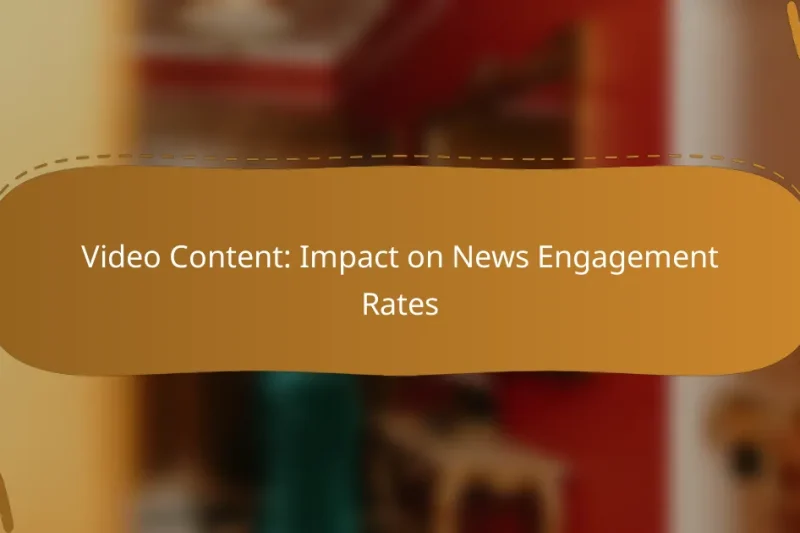In the competitive landscape of news apps, user experience plays a crucial role in determining how … Major News Apps: User Experience ComparisonRead more
Evolution of Global News Platforms
The evolution of global news platforms has marked a significant shift from traditional print media to dynamic digital formats, driven by advancements in technology and changing consumer behaviors. This transformation emphasizes the need for immediacy and accessibility in news delivery, while also presenting challenges such as declining advertising revenues and the spread of misinformation. As these platforms adapt, they explore various monetization strategies to sustain their operations and engage audiences effectively.
Push Notifications: Effectiveness in News Delivery
Push notifications have emerged as a powerful tool for news delivery, providing immediate alerts that capture … Push Notifications: Effectiveness in News DeliveryRead more
Subscription-Based News Models: Pros and Cons
Subscription-based news models have emerged as a significant alternative to traditional ad-supported journalism, providing stable revenue … Subscription-Based News Models: Pros and ConsRead more
Podcasts: Role in Modern News Consumption
Podcasts are revolutionizing news consumption by providing a flexible and engaging format that fits seamlessly into … Podcasts: Role in Modern News ConsumptionRead more
Video Content: Impact on News Engagement Rates
Video content plays a crucial role in boosting news engagement rates by effectively capturing audience attention … Video Content: Impact on News Engagement RatesRead more
Mobile Optimization: Influence on News Readership
Mobile optimization plays a crucial role in enhancing news readership by making content more accessible and … Mobile Optimization: Influence on News ReadershipRead more
News Aggregators: Future Expectations for Consumers
The future of news aggregators in the US is set to transform consumer experiences through enhanced … News Aggregators: Future Expectations for ConsumersRead more
How have global news platforms evolved over time?
Global news platforms have transformed significantly, shifting from traditional print media to digital formats that prioritize immediacy and accessibility. This evolution reflects changes in technology, consumer behavior, and the demand for real-time information.
Shift from print to digital
The transition from print to digital news platforms began in the late 20th century, driven by the internet’s rise. Newspapers and magazines adapted by creating online versions, which allowed for instant updates and broader reach.
Digital news platforms often employ multimedia elements, such as videos and interactive graphics, enhancing user engagement. Many traditional outlets now offer subscription models to monetize their online content, reflecting a shift in revenue strategies.
Rise of social media as news sources
Social media has emerged as a primary source of news for many people, particularly younger demographics. Platforms like Twitter, Facebook, and Instagram allow users to share and consume news quickly, often outpacing traditional media outlets.
However, the reliance on social media for news raises concerns about misinformation and the quality of reporting. Users should verify information from multiple sources to ensure accuracy and reliability.
Impact of mobile technology on news consumption
Mobile technology has revolutionized how news is consumed, with smartphones enabling access to news anytime and anywhere. This shift has led to shorter attention spans, prompting news organizations to create more concise and engaging content.
Many news apps now offer personalized news feeds, allowing users to tailor their experience based on interests. Notifications and alerts keep users informed of breaking news, further emphasizing the need for timely reporting in a fast-paced digital environment.
What are the key challenges facing global news platforms?
Global news platforms face several significant challenges, including declining advertising revenues, combatting misinformation, and maintaining audience engagement. Each of these issues requires strategic approaches to ensure sustainability and credibility in a rapidly changing media landscape.
Declining advertising revenues
Declining advertising revenues are a major challenge for global news platforms, as traditional ad models struggle to compete with digital alternatives. Many platforms have seen a drop in income from print and broadcast ads, leading to budget cuts and reduced staffing.
To adapt, news organizations are exploring diverse revenue streams such as subscription models, sponsored content, and partnerships. For instance, some platforms offer premium memberships that provide ad-free experiences or exclusive content, which can help offset lost advertising income.
Combatting misinformation
Combatting misinformation is crucial for maintaining trust and credibility in global news platforms. With the rise of social media, false information can spread rapidly, undermining journalistic integrity and public understanding.
News organizations are implementing fact-checking initiatives and collaborating with technology companies to identify and flag misleading content. Training journalists in media literacy and critical thinking can also empower audiences to discern credible news from misinformation.
Maintaining audience engagement
Maintaining audience engagement is essential for the survival of global news platforms, particularly in a crowded digital space. As consumer preferences shift, platforms must innovate to capture and retain viewer interest.
Strategies include utilizing interactive content, such as polls and live discussions, and leveraging social media to foster community engagement. Personalization through algorithms can also enhance user experience by delivering tailored news feeds, encouraging regular visits and interactions.
How do global news platforms monetize content?
Global news platforms monetize content primarily through advertising, subscriptions, and partnerships. Each method has its own advantages and challenges, influencing how news organizations generate revenue while maintaining audience engagement.
Display advertising strategies
Display advertising involves placing visual ads on news websites, which can be targeted based on user demographics and behavior. This strategy typically includes banner ads, video ads, and interactive content, allowing platforms to earn revenue based on impressions or clicks.
Key considerations include ad placement and user experience; intrusive ads may drive away readers. News platforms often use programmatic advertising to automate the buying and selling of ad space, optimizing revenue potential.
Subscription models
Subscription models require users to pay for access to premium content, often providing ad-free experiences or exclusive articles. Many global news platforms offer tiered subscription plans, allowing users to choose between basic and premium access.
Successful subscription strategies focus on delivering high-quality, unique content that justifies the cost. Platforms should consider offering trial periods or discounted rates to attract new subscribers and retain existing ones.
Sponsored content partnerships
Sponsored content partnerships involve collaborating with brands to create articles or videos that promote their products while providing value to the audience. This approach can enhance revenue without compromising editorial integrity if done transparently.
News platforms should ensure that sponsored content aligns with their audience’s interests and maintains journalistic standards. Clearly labeling sponsored content helps build trust and keeps readers informed about the nature of the material they are consuming.
What role do major news organizations play in the global landscape?
Major news organizations serve as critical players in the global news landscape by shaping public perception and providing information across borders. They influence how events are reported, interpreted, and understood by audiences worldwide.
Influence of CNN on international reporting
CNN has been a pioneer in international news coverage, often being the first to report on breaking global events. Its 24-hour news cycle allows for continuous updates, which has set a standard for real-time reporting.
The network’s focus on live broadcasting from conflict zones and major global events has made it a trusted source for many viewers. However, its approach can sometimes lead to sensationalism, which may skew public perception.
BBC’s global reach and credibility
The BBC is renowned for its extensive global reach and commitment to impartial reporting. With correspondents stationed around the world, it provides in-depth coverage of international affairs, making it a go-to source for reliable news.
Its funding model, primarily through the license fee in the UK, allows it to maintain independence from commercial pressures, which enhances its credibility. However, it faces challenges in adapting to the digital landscape and competing with faster news outlets.
Al Jazeera’s impact on Middle Eastern narratives
Al Jazeera has significantly influenced the portrayal of Middle Eastern events, offering perspectives often overlooked by Western media. Its focus on regional issues has helped to amplify local voices and narratives.
By providing coverage in multiple languages, Al Jazeera reaches a diverse audience, contributing to a broader understanding of complex geopolitical dynamics. Nonetheless, it has faced criticism for perceived biases, particularly in its coverage of conflicts involving Arab nations.
How do emerging technologies shape news delivery?
Emerging technologies significantly influence how news is delivered, enhancing accessibility and engagement. Innovations like artificial intelligence, virtual reality, and blockchain are transforming traditional news platforms by improving content curation, creating immersive experiences, and ensuring transparency in distribution.
Use of AI in content curation
AI plays a crucial role in content curation by analyzing user preferences and behavior to deliver personalized news feeds. Algorithms can sift through vast amounts of data, identifying trending topics and relevant articles, which helps users stay informed without overwhelming them.
News organizations are increasingly adopting AI tools to automate the selection and presentation of news stories. For example, platforms like Google News utilize AI to tailor content based on individual reading habits, enhancing user engagement and satisfaction.
Virtual reality in immersive journalism
Virtual reality (VR) offers a groundbreaking approach to journalism by creating immersive experiences that allow audiences to engage with stories on a deeper level. Through VR, users can virtually attend events or explore environments related to news stories, making the information more impactful.
Media companies are experimenting with VR to cover significant events, such as natural disasters or political rallies. For instance, a VR experience might allow viewers to walk through a disaster zone, providing a visceral understanding of the situation that traditional media cannot convey.
Blockchain for transparent news distribution
Blockchain technology enhances transparency in news distribution by providing a decentralized and immutable record of content creation and sharing. This ensures that news articles can be traced back to their original sources, helping to combat misinformation and verify authenticity.
Several startups are exploring blockchain for news distribution, allowing journalists to publish their work directly to consumers without intermediaries. This model not only increases trust but also enables fair compensation for content creators through smart contracts, which can automatically distribute payments based on engagement metrics.
What are the future trends in global news platforms?
The future of global news platforms is leaning towards enhanced personalization and the integration of advanced technologies. As audiences demand more tailored content, platforms are adapting to provide news that aligns closely with individual preferences and behaviors.
Increased personalization of news feeds
Increased personalization of news feeds allows users to receive content that matches their interests and reading habits. Algorithms analyze user behavior, such as articles read and time spent on specific topics, to curate a unique news experience. This trend is driven by the need for engagement in a crowded media landscape.
Platforms like Facebook and Google News utilize machine learning to refine their personalization strategies. Users can expect to see news articles that reflect their geographical location, preferred topics, and even sentiment analysis based on their interactions. This creates a more relevant and engaging reading experience.
However, there are trade-offs to consider. Over-personalization can lead to echo chambers, where users are only exposed to viewpoints that reinforce their existing beliefs. To mitigate this, users should actively seek diverse sources and perspectives to ensure a well-rounded understanding of current events.






